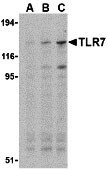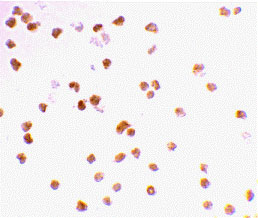TLR7 Antibody
- SPECIFICATION
- CITATIONS
- PROTOCOLS
- BACKGROUND

Application
| WB, ICC, E |
|---|---|
| Primary Accession | P58681 |
| Other Accession | NP_573474, 18875360 |
| Reactivity | Human, Mouse |
| Host | Rabbit |
| Clonality | Polyclonal |
| Isotype | IgG |
| Calculated MW | Predicted: 116 kDa Observed: 135 kDa |
| Application Notes | TLR7 antibody can be used for detection of TLR7 by Western blot at 0.5 to 2 µg/mL. Antibody can also be used for immunocytochemistry starting at 2 µg/mL. |
| Gene ID | 170743 |
|---|---|
| Other Names | TLR7 Antibody: Toll-like receptor 7, toll-like receptor 7 |
| Target/Specificity | Tlr7; |
| Reconstitution & Storage | TLR7 antibody can be stored at 4℃ for three months and -20℃, stable for up to one year. As with all antibodies care should be taken to avoid repeated freeze thaw cycles. Antibodies should not be exposed to prolonged high temperatures. |
| Precautions | TLR7 Antibody is for research use only and not for use in diagnostic or therapeutic procedures. |
| Name | Tlr7 |
|---|---|
| Function | Endosomal receptor that plays a key role in innate and adaptive immunity. Controls host immune response against pathogens through recognition of uridine-containing single strand RNAs (ssRNAs) of viral origin or guanosine analogs (PubMed:21402738). Upon binding to agonists, undergoes dimerization that brings TIR domains from the two molecules into direct contact, leading to the recruitment of TIR- containing downstream adapter MYD88 through homotypic interaction. In turn, the Myddosome signaling complex is formed involving IRAK4, IRAK1, TRAF6, TRAF3 leading to activation of downstream transcription factors NF-kappa-B and IRF7 to induce pro-inflammatory cytokines and interferons, respectively (PubMed:14976261) (By similarity). |
| Cellular Location | Endosome membrane. Endoplasmic reticulum membrane; Single- pass type I membrane protein. Lysosome. Cytoplasmic vesicle, phagosome. Note=Relocalizes from endoplasmic reticulum to endosome and lysosome upon stimulation with agonist |

Thousands of laboratories across the world have published research that depended on the performance of antibodies from Abcepta to advance their research. Check out links to articles that cite our products in major peer-reviewed journals, organized by research category.
info@abcepta.com, and receive a free "I Love Antibodies" mug.
Provided below are standard protocols that you may find useful for product applications.
Background
TLR7 Antibody: Toll-like receptors (TLRs) are signaling molecules that recognize different microbial products during infection and serve as an important link between the innate and adaptive immune responses. These proteins act through adaptor molecules such as MyD88 and TIRAP to activate various kinases and transcription factors. TLR7, like TLRs 3, 8, and 9, is localized in intracellular acidic compartments such as the phagolysosome and will recognize some single-stranded RNA viruses such as vesicular stomatitis virus (VSV) and influenza virus. Activation of TLR7 by VSV results in stimulation of the immune response including IFNalpha secretion, suggesting the importance of TLR7 in virus recognition.
References
Vogel SN, Fitzgerald KA, and Fenton MJ. TLRs: differential adapter utilization by toll-like receptors mediates TLR-specific patterns of gene expression. Mol. Interv. 2003; 3:466-77.
Takeda K, Kaisho T, and Akira S. Toll-like receptors. Annu. Rev. Immunol. 2003; 21:335-76.
Janeway CA Jr. and Medzhitov R. Innate immune recognition. Annu. Rev. Immunol. 2002; 20:197-216.
O’Neill LAJ, Fitzgerald FA, and Bowie AG. The Toll-IL-1 receptor adaptor family grows to five members. Trends in Imm. 2003; 24:286-9.
If you have used an Abcepta product and would like to share how it has performed, please click on the "Submit Review" button and provide the requested information. Our staff will examine and post your review and contact you if needed.
If you have any additional inquiries please email technical services at tech@abcepta.com.













 Foundational characteristics of cancer include proliferation, angiogenesis, migration, evasion of apoptosis, and cellular immortality. Find key markers for these cellular processes and antibodies to detect them.
Foundational characteristics of cancer include proliferation, angiogenesis, migration, evasion of apoptosis, and cellular immortality. Find key markers for these cellular processes and antibodies to detect them. The SUMOplot™ Analysis Program predicts and scores sumoylation sites in your protein. SUMOylation is a post-translational modification involved in various cellular processes, such as nuclear-cytosolic transport, transcriptional regulation, apoptosis, protein stability, response to stress, and progression through the cell cycle.
The SUMOplot™ Analysis Program predicts and scores sumoylation sites in your protein. SUMOylation is a post-translational modification involved in various cellular processes, such as nuclear-cytosolic transport, transcriptional regulation, apoptosis, protein stability, response to stress, and progression through the cell cycle. The Autophagy Receptor Motif Plotter predicts and scores autophagy receptor binding sites in your protein. Identifying proteins connected to this pathway is critical to understanding the role of autophagy in physiological as well as pathological processes such as development, differentiation, neurodegenerative diseases, stress, infection, and cancer.
The Autophagy Receptor Motif Plotter predicts and scores autophagy receptor binding sites in your protein. Identifying proteins connected to this pathway is critical to understanding the role of autophagy in physiological as well as pathological processes such as development, differentiation, neurodegenerative diseases, stress, infection, and cancer.



